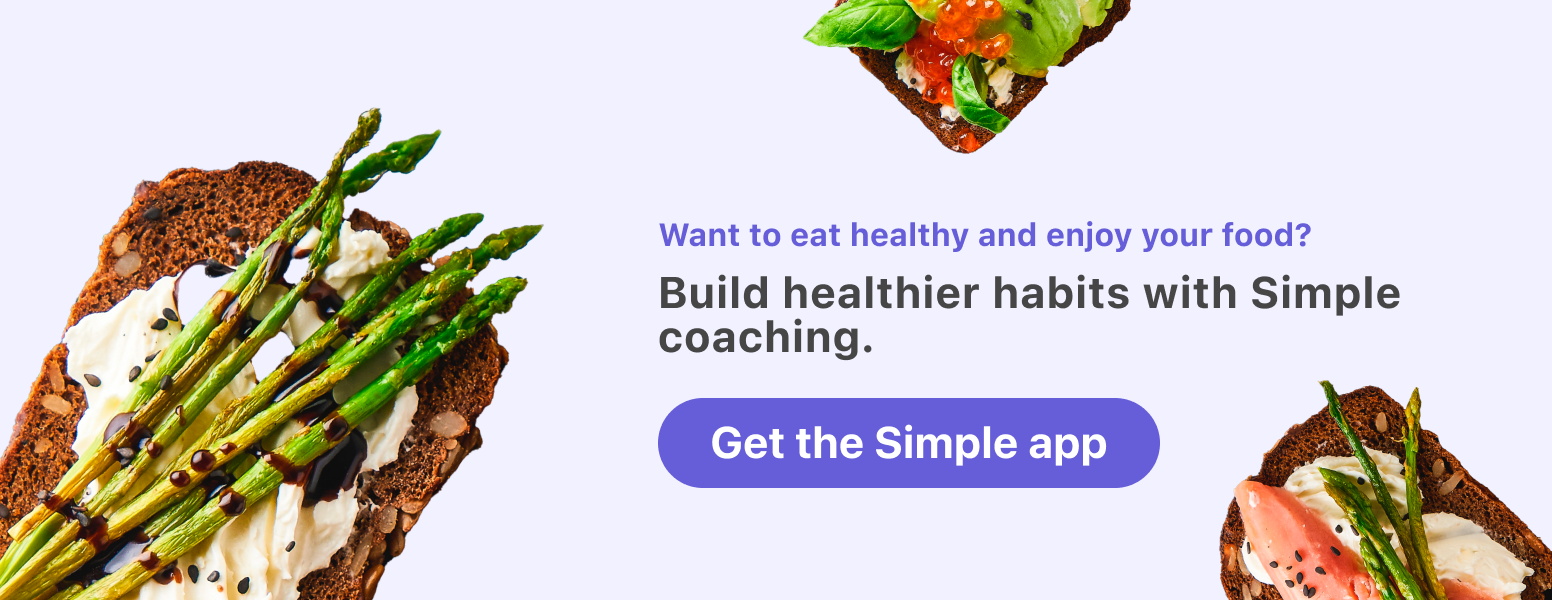Mindful eating 101: how to eat mindfully

If you’re like most people, chances are you rush through your day, ruminating about the past or worrying about the future. Plus, you might find yourself distracted by all the peeps and pings of your electronic devices, frustrated by traffic, frazzled by your kids or your boss, and so on.
If so, you’re not alone.
Most of us forget to slow down, calm down, and focus on the present moment.

While that’s normal, it’s also a problem.
Being in a mindless state — busily going on autopilot — can mean we make poor choices, ignore our bodies’ needs, and aren’t aware of our behaviors.
This can be stressful and frustrating, especially when we “wake up” from a daze, realizing we made decisions that didn’t align with our goals.
On the other hand, improving our mindfulness, even in small ways, can help us lose weight, get healthier, and give our bodies what they really need.
Looking to weave mindfulness into your eating habits with ease? Simple has you covered! With our smart food tracker, you can record what you’ve eaten just by telling the app; no endless scrolling is needed. And if you’re trying intermittent fasting, our fasting tracker provides daily guidance and lets you know when you’re in “fat-burning mode.” Curious? Take the Simple quiz now and discover how we can make your mindful journey even smoother.
What is mindfulness?
The concept of mindfulness is simple: purposely being aware of the present moment without judgment.[1]
This could mean awareness of:
- body sensations, like hunger
- sensory input, like sounds or smells
- choices you’re making
- thoughts you’re having
- emotions you’re feeling
- your surroundings in that moment
Of course, you don’t have to catalog all of these. You just pause and … notice.

What is mindful eating?
Mindful eating means:[1,2,3,4]
- slowing down to notice what’s happening in that moment without judgment;
- noticing all of the things listed above — body sensations like hunger, sensory input like taste, your thoughts, and so on; and
- accepting and allowing whatever comes up.
Mindful eating isn’t a diet. There are no rules about serving sizes, types of foods, or macronutrients and micronutrients. Rather, mindful eating just focuses on the moment-to-moment process of making food choices and eating rather than the outcome.
The intention is to fully savor the moment, enjoy the pleasures of food, and allow your body’s inner wisdom to guide your food choices. Each meal can be a different experience, which is a wonderful thing.
Between meals, mindfulness also helps us stay more aware of our physiological hunger cues and distinguish these from cravings, emotional eating, or “the food was there, so I ate it” experiences.
Why eat mindfully?
Mindful eating can cut through the “noise” of dietary information, fad diets, and internet “influencers” to bring peace to your mealtimes.
By being fully present and conscious, without judgment, mindful eating can help you enjoy:
- more self-kindness and self-compassion for yourself and your journey
- more awareness of your body’s sensations, like internal hunger and fullness cues, or whether a certain food or portion size “works” for your body
- more joy and satisfaction for new and old foods
- more healthy control over emotional and stress-eating behavior
- a healthier relationship with food and your body
In general, these can all help people feel and function better. They can help folks build self-trust and relax around mealtimes.
These can also improve overall wellness and help us gently but persistently change behaviors that don’t help us.
For instance, mindfulness and mindful eating can help people:
- eat the right amount of food for their bodies’ needs [5]
- reduce emotional eating [6,7]
- address disordered eating patterns [2,8]
- digest food better [9]
- make wiser, more thoughtful food choices — rather than impulsive “grab ‘n’ go” options [10,11]
Mindful eating and weight loss
Mindful eating can help people lose weight, often more easily and effortlessly.[3,12,13]
When people slow down, check in, and notice what they are eating and how they feel, they often eat less while feeling more satisfied. They’re also less likely to make impulsive, rushed food choices and opt for nutritious foods that help their bodies feel good.
Mindful eating helps people get off the “diet rules train” and use their own “inner wisdom” to guide them.
A step-by-step guide to mindful eating

Mindful eating is a skill that takes practice. So, try it out and recognize that it will take time to feel natural or easy. Keep at it!
Before meals
Before you eat, pause. “Check in” with yourself.
Ask yourself:
- Am I hungry? How do I know?
- What am I feeling in my body?
- What am I feeling emotionally?
- What am I thinking?
Consider the food choice you’re about to make.
Ask yourself:
- What am I choosing to eat right now?
- Will this food make me feel good and energized?
- Is this a wise choice for me right now?
There are no wrong answers. The goal is to pause and pay attention.
During meals
Clear the table of distractions. Turn off your phone and the TV.
Take a bite. Chew slowly. Put your utensils down.
Take a deep breath and consciously relax your body. Notice how your body feels, and quickly check in with how hungry or full you are. Count to five and pick up your utensils for the next bite.
When you eat, pay attention to your food. In particular, notice the:
- Flavor: is it bitter, sweet, salty, buttery, light, etc.? Does the flavor change as you chew?
- Texture: how does the food feel in your mouth? Are there ridges? Is it smooth, chewy, hard, or soft, etc.?
- Temperature: is it hot? Do you prefer it cold or room temperature?
- Smell: smell dramatically impacts the flavor.
- Visual appearance: is it colorful, bland, plated nicely or thrown together, etc.?
After a meal
Get up and walk around a little bit immediately. This can be a great way of assessing how full you are.
With some practice, you’ll be able to hit just the right amount of fullness: satisfied and no longer hungry … but not stuffed.
Want to stay even more attuned to your body’s needs while practicing mindfulness? With Simple’s hydration tracker, you’ll be reminded to stay energized with the right fluid intake throughout your fasting periods. Plus, our progress tracker helps celebrate each milestone, keeping you motivated and in the present. Ready to amplify your mindfulness game? Dive into the Simple quiz, and let’s get started!

Build your mindfulness muscle with these exercises
It can take time to integrate mindfulness into your life. These quick, relaxing exercises can help — they’re especially effective on a stressful day. It takes time and practice, but you will get the hang of it!
Breathing
Help your body slow down and settle with deliberate breathing. Focus on a slow out-breath, like gradually blowing up a big balloon.
Breathe out slowly for several seconds, like a long sigh. Pause for a very brief moment. Then, relax your body and let the in-breath happen naturally.
Try 2–3 of these (or more) before a meal.
Body scan
A quick “body scan” can help you practice observing body sensations. Sit or lie quietly.
Then, start at your feet. Notice how they feel. Squeeze the muscles of your feet and then relax. Observe how contracting the muscles changes the sensations.
Then, move up from your feet and squeeze and relax every part of your body, from toe to head.
Notice any sensations, emotions, or thoughts that surface as you focus on each part.
Mini-environmental scan
If you feel anxious, distracted, or unsettled, try a “mini environmental scan.” Stop what you’re doing. Focus on your immediate surroundings and pick out three background noises, like the wind, traffic, or a ticking clock.
Then, choose two objects to focus on, like a tree or the details on a windowpane. Or see if you can find particular types of objects, like things that are green.
This exercise of noticing your real environment can help “ground” you when your thoughts and imagination are spinning up.
Notice the small details of life
Find joy and satisfaction in the simple pleasures of just existing.
For instance, when you pour your morning coffee or tea, listen to the sound. Smell the aroma. Sniff before you sip. Savor the taste.
When you walk outside, slow down to notice small details and sensory inputs — the sound of a bird, the color of the leaves, the smell of the air, the sensation of your feet on the ground, and so on.
Yes, mindful eating can complement various dietary approaches. It encourages conscious food choices, which can be integrated into different eating plans.
Intermittent fasting, in particular, might help with mindful eating, as it encourages people to notice and calmly accept a bit of mild hunger rather than panicking or leaping to “fix” it.
The effects of mindful eating can vary from person to person, but many people report positive changes in their relationship with food and well-being within a few weeks to months of consistent practice.
And some people say that one slow and mindful meal changes their life! (It can be pretty amazing — sometimes even a little shocking — to finish a meal actually feeling naturally satisfied if you’re not used to it!)As you venture into the world of mindful eating, wouldn’t it be great to have a tool that effortlessly complements your journey? From Nutrition Scores that give you a personalized assessment to an activity tracker that ensures you’re moving just right, Simple is designed to be your companion.
And hey, if you’re wondering about the intricate details of your meals, our progress tracker is there to capture every bite. Intrigued? Take our Simple quiz and see how we can walk this mindful path together.

- Nelson JB. Mindful eating: The art of presence while you eat. Diabetes Spectr. 2017 Aug;30(3):171–4.
- Kristeller JL, Wolever RQ. Mindfulness-based eating awareness training for treating binge eating disorder: The conceptual foundation. Eat Disord. 2011 Jan-Feb;19(1):49–61.
- Lofgren IE. Mindful eating: An emerging approach for healthy weight management. Am J Lifestyle Med. 2015 May 1;9(3):212–6.
- Tapper K. Mindful eating: What we know so far. Nutr Bull. 2022 Jun;47(2):168–85.
- Grider HS, Douglas SM, Raynor HA. The influence of mindful eating and/or intuitive eating approaches on dietary intake: A systematic review. J Acad Nutr Diet. 2021 Apr;121(4):709–27.e1.
- O’Reilly GA, Cook L, Spruijt-Metz D, Black DS. Mindfulness-based interventions for obesity-related eating behaviours: A literature review. Obes Rev. 2014 Jun;15(6):453–61.
- Frayn M, Livshits S, Knäuper B. Emotional eating and weight regulation: A qualitative study of compensatory behaviors and concerns. J Eat Disord. 2018 Sep 14;6:23.
- Daubenmier J, Kristeller J, Hecht FM, Maninger N, Kuwata M, Jhaveri K, et al. Mindfulness intervention for stress eating to reduce cortisol and abdominal fat among overweight and obese women: An exploratory randomized controlled study. J Obes. 2011 Oct 2;2011:651936.
- Cherpak CE. Mindful eating: A review of how the stress-digestion-mindfulness triad may modulate and improve gastrointestinal and digestive function. Integr Med . 2019 Aug;18(4):48–53.
- Hendrickson KL, Rasmussen EB. Mindful eating reduces impulsive food choice in adolescents and adults. Health Psychol. 2017 Mar;36(3):226–35.
- Jordan CH, Wang W, Donatoni L, Meier BP. Mindful eating: Trait and state mindfulness predict healthier eating behavior. Pers Individ Dif. 2014 Oct 1;68:107–11.
- Carrière K, Khoury B, Günak MM, Knäuper B. Mindfulness-based interventions for weight loss: A systematic review and meta-analysis. Obes Rev. 2018 Feb;19(2):164–77.
- Mantzios M, Wilson JC. Mindfulness, eating behaviours, and obesity: A review and reflection on current findings. Curr Obes Rep. 2015 Mar;4(1):141–6.
